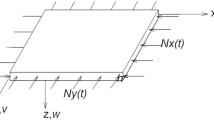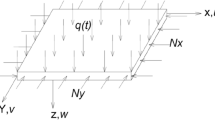Abstract
The dynamic power transmission characteristics of a finite stiffened Mindlin plate subject to different boundary conditions are analytically studied. The stiffened plate is modeled as a coupled structure comprising a plate and stiffeners. Dynamic responses calculated by the analytical solutions are verified through comparison of the results with those generated using the finite element method. The computed results show that Mindlin plate and Timoshenko beam theory is more suitable for studying dynamic power of the stiffened plate over a broad frequency range than classical plate and beam theory. The stiffness and inertia characteristics of the Mindlin plate can be enhanced using the stiffeners, which can significantly affect the dynamic response, especially in low-frequency range. It can be also noticed that the stop band in the low-frequency range can become wider by increasing the number and dimension (height and width) of the stiffeners, so vibratory power of the stiffened Mindlin plate in the low-frequency range can be greatly reduced.











Similar content being viewed by others
References
Cuschieri, J.M.: Structural power-flow analysis using a mobility approach of an L-shaped plate. J. Acoust. Soc. Am. 87(3), 1159–1165 (1990)
Niu, B., Olhoff, N.: Minimization of vibration power transmission from rotating machinery to a flexible supporting plate. Int. J. Struct. Stab. Dyn. 14, 1350068 (2014)
Bahrami, A., Teimourian, A.: Small scale effect on vibration and wave power reflection in circular annular nanoplates. Compos. Part B 109, 214–226 (2017)
Mohanta, R.K., Chelliah, T.R., Allamsetty, S., Akula, A., Ghosh, R.: Sources of vibration and their treatment in hydro power stations-A review. Eng. Sci. Technol., Int. J. 20, 637–648 (2016)
Heo, Y., Kim, K.: Definitions of non-stationary vibration power for time-frequency analysis and computational algorithms based upon harmonic wavelet transform. J. Sound Vib. 336, 275–292 (2015)
Milovančević, M., Nikolić, V., Andelković, B.: Analyses of the most influential factors for vibration monitoring of planetary power transmissions in pellet mills by adaptive neuro-fuzzy technique. Mech. Syst. Signal Process. 82, 356–375 (2017)
Jin, M., Pan, J.: Vibration transmission from internal structures to the tank of an oil-filled power transformer. Appl. Acoust. 113, 1–6 (2016)
Chevva, K., Sun, F., Blanc, A., Mendoza, J.: Active vibration control using minimum actuation power. J. Sound Vib. 340, 1–21 (2015)
Yang, J., Xiong, Y.P., Xing, J.T.: Vibration power flow and force transmission behaviour of a nonlinear isolator mounted on a nonlinear base. Int. J. Mech. Sci. 115–116, 238–252 (2016)
Seo, S.H., Hong, S.Y., Kil, H.G.: Power flow analysis of reinforced beam-plate coupled structures. J. Sound Vib. 259, 1109–1129 (2003)
Cuschieri, J.M., McCollum, M.D.: In-plane and out-of-plane waves’ power transmission through a L-plate junction using the mobility power flow approach. J. Acoust. Soc. Am. 100(2), 857–870 (1996)
Park, Y.H., Hong, S.Y.: Vibrational power flow models for transversely vibrating finite Mindlin plate. J. Sound Vib. 317, 800–840 (2008)
Chen, Y., Jin, G., Du, J., Liu, Z.: Vibration characteristics and power transmission of coupled recta. Chin. J. Mech. Eng. 25, 262–276 (2012)
Liu, C.C., Li, F.M., Fang, B., Zhao, Y., Huang, W.H.: Active control of power flow transmission in finite connected plate. J. Sound Vib. 329, 4124–4135 (2010)
Liu, C.C., Li, F.M., Liang, T.W., Huang, W.H.: The wave and vibratory power transmission in finite L-shaped Mindlin plate with two simply supported opposite edges. Acta Mech. Sin. 27, 785–795 (2011)
Kessissoglou, N.J.: Active control of the plate energy transmission in a semi-infinite ribbed plate. J. Acoust. Soc. Am. 107, 324–331 (2000)
Lin, T.R.: A study of modal characteristics and the control mechanism of finite periodic and irregular ribbed plates. J. Acoust. Soc. Am. 123(2), 729–737 (2008)
Lin, T.R., Pan, J., Mechefske, C.: The effect of off-neutral axis excitation on the vibration response of finite ribbed plates. J. Vib. Acoust. 131, 011011 (2009)
Mace, B.R.: Power flow between two continuous one-dimension subsystems: a wave solution. J. Sound Vib. 154(2), 289–319 (1992)
Mace, B.R.: The Statistics of power flow between two continuous one dimension subsystems. J. Sound Vib. 154(2), 321–341 (1992)
Carcaterra, A., Sestieri, A.: Energy density equations and power flow in structures. J. Sound Vib. 188(2), 269–282 (1995)
Kessissoglou, N.J., Pan, J.: An analytical investigation of the active attenuation of the plate flexural wave transmission through a reinforcing beam. J. Acoust. Soc. Am. 102, 3530–3541 (1997)
Kessissoglou, N.J.: An analytical and experimental investigation on active control of the flexural wave transmission in a simply supported ribbed plate. J. Sound Vib. 240(1), 73–85 (2001)
Keir, J., Kessissoglou, N.J., Norwood, C.: An analytical investigation of single actuator and error sensor control in connected plates. J. Sound Vib. 271(2), 635–649 (2004)
Keir, J., Kessissoglou, N.J., Norwood, C.J.: Active control of connected plates using single and multiple actuators and error sensors. J. Sound Vib. 281(1), 73–97 (2005)
Vemula, C., Norris, A.N.: Flexural wave propagation and scattering on thin plates using Mindlin theory. Wave Motion 26, 1–12 (1997)
Wang, C.D., Wang, C.M.: Computation of the stress resultants of a floating Mindlin plate in response to linear wave forces. J. Fluids Struct. 24, 1042–1057 (2008)
Hu, C., Chen, T., Han, G., Huang, W.H.: Flexural wave propagation and localized vibration in narrow Mindlin’s plate. J. Sound Vib. 306, 389–399 (2007)
Movchan, N.V., Mcphedran, R.C., Movchan, A.B.: Flexural waves in structured elastic plates: Mindlin versus bi-harmonic models. Proc. R. Soc. A: Math., Phys. Eng. Sci. 467, 869–880 (2011)
Liew, K.M., Xiang, Y., Kinipornchai, S., Meek, J.L.: Formulation of Mindlin–Engesser model for stiffened plate vibration. Comput. Method Appl. Mech. Eng. 120, 339–353 (1995)
Lin, T.R.: An analytical and experimental study of the vibration response of a clamped ribbed plate. J. Sound Vib. 331, 902–913 (2012)
Pao, Y.H., Mow, C.C.: Diffraction of Elastic Waves and Dynamic Stress Concentrations. Crane, Russak & Company Inc., New York (1973)
Acknowledgements
This research is supported by the National Natural Science Foundation of China (Nos. 11761131006, 11572007, 11402067, 11172084).
Author information
Authors and Affiliations
Corresponding authors
Additional information
Publisher's Note
Springer Nature remains neutral with regard to jurisdictional claims in published maps and institutional affiliations.
Appendix A
Appendix A
The elements of the amplitude coefficient matrix in Eq. (28) are as follows:

where,
The elements \({\varvec{\Pi }} _{01}\) and \({\varvec{\Pi }} _{(N+1)2}\) can be determined by the boundary conditions at the edges \(x =0\) and \(x=L_{x}\), and they are different for the different boundary conditions.
Rights and permissions
About this article
Cite this article
Liu, C., Zhang, J. & Li, F. Power transmission and suppression characteristics of stiffened Mindlin plate under different boundary constraints. Arch Appl Mech 89, 1705–1721 (2019). https://doi.org/10.1007/s00419-019-01538-9
Received:
Accepted:
Published:
Issue Date:
DOI: https://doi.org/10.1007/s00419-019-01538-9




